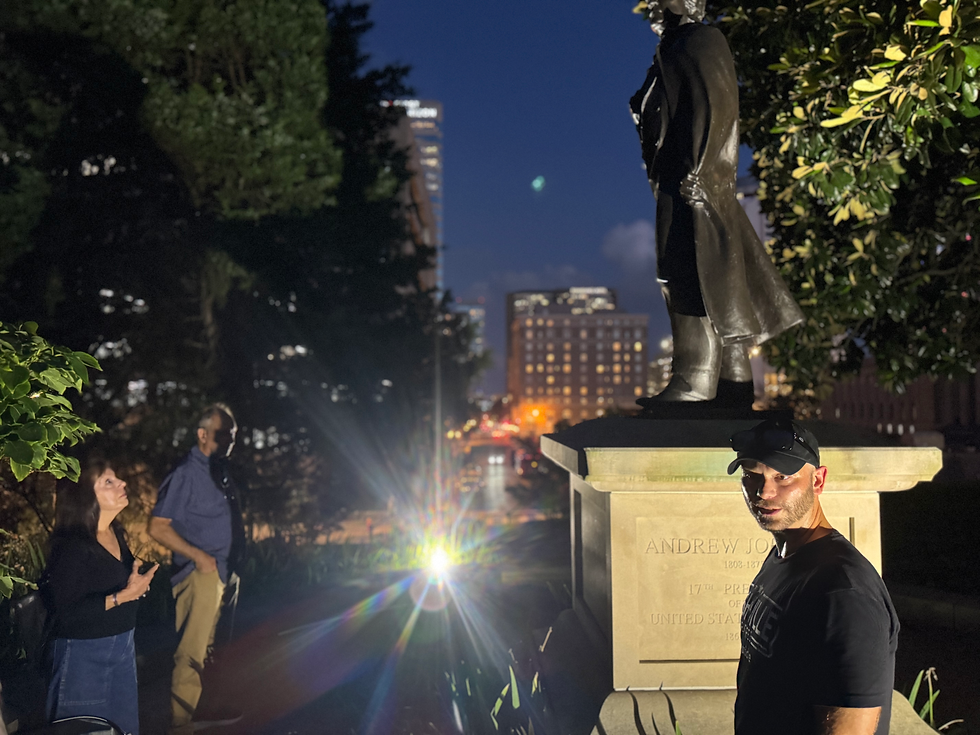Legacy of President James K. Polk in Nashville
- Cody Witten

- Sep 3, 2025
- 4 min read
Updated: Sep 7, 2025

Nashville is a city where history presses in from every corner. Beyond the music and nightlife, its past is marked by epidemics, political struggles, and the lingering shadows of the Civil War. At the heart of that history stands President James K. Polk, one of the most transformative yet often overlooked figures in American politics. Today, his tomb rests on the grounds of the Tennessee State Capitol — but some say his story didn’t end with stone and marble. For those who listen closely, the legacy of Polk carries an unsettling, ghostly edge.
Who Was James K. Polk?
James Knox Polk, born in 1795 in North Carolina, rose to become the 11th President of the United States. Known as a workaholic and one of the hardest-working presidents in history, Polk accomplished more in his single term than many presidents did in two. He expanded the boundaries of the United States more than any other president, bringing Texas, California, Oregon, and much of the Southwest into the nation. By the end of his four years (1845–1849), America stretched from the Atlantic Ocean to the Pacific.
Despite his monumental achievements, Polk is often overlooked in popular memory. But here in Nashville, his story — and his ghostly legend — are very much alive.
Polk’s Tragic End
Polk kept his promise not to run for a second term and returned to Nashville with plans to enjoy a quiet retirement at Polk Place, his family home near downtown. But that peace never came. Just three months after leaving office, he contracted cholera during an outbreak that swept through the city. On June 15, 1849, at the age of only 53, Polk died, leaving behind his widow Sarah Childress Polk.
His death was a shock not only to Nashville but to the nation. After shaping the map of America, Polk barely lived long enough to see the country he helped create.
A Restless Burial
If Polk’s story ended there, it would already be poignant. But the strange tale of his body adds an unsettling twist.
Polk was first buried in Nashville City Cemetery, the resting place for thousands of early Nashvillians. But within a year, his widow Sarah had his remains moved to the garden of Polk Place, their mansion near downtown. For decades, Sarah tended the home and hosted Nashville society there, keeping her husband’s memory alive.
After her death in 1891, Polk Place was demolished — and Polk’s remains were moved again. Today, he and Sarah rest in a tomb on the grounds of the Tennessee State Capitol, overlooking the city.
That makes at least three burials in just over 40 years. Some historians and paranormal enthusiasts suggest that such disturbance could leave a spirit restless. After all, if the living struggle to find peace after being uprooted, why wouldn’t the dead?
Ghostly Whispers at the Capitol
Visitors to the Capitol grounds have long whispered about odd experiences near Polk’s tomb. Cold breezes where none should be. Strange shadows cast against the stone at night. A heavy stillness, like someone is watching.
Is it merely the weight of history that makes people uneasy, or could Polk himself still linger? Nashville is layered with tragedy — epidemics, fires, duels, and the trauma of the Civil War just outside the city — so it’s hard to say whether the spirits felt there belong to Polk, a soldier, or someone else entirely. But it’s undeniable: the Capitol grounds have an energy that makes people pause.
Why Polk Still Matters To Modern Times and to Nashville
Even if you don’t believe in ghosts, James K. Polk’s presence in Nashville is haunting in another way. He is a reminder of how history is woven into the very streets of this city. You can stroll down Broadway, listening to a band cover Johnny Cash, then walk a few blocks uphill and find yourself face-to-face with the tomb of a president who changed the course of the nation.
Polk’s life also reminds us of the fragility of time. Here was a man who expanded a nation by millions of acres but couldn’t enjoy retirement for even a single season. That sense of a life cut short, of ambitions left unfulfilled, is perhaps why his story lends itself so easily to ghostly lore.
Polk’s Widow: Sarah Childress Polk
It’s impossible to tell Polk’s story without mentioning Sarah. She lived for over 40 years after her husband’s death and became one of the most respected figures in Nashville society. Known as “The Widow Polk,” she hosted politicians, soldiers, and celebrities in her home — even as the Civil War raged around her. Some say she fiercely guarded Polk’s memory, and in a way, continues to do so.
Could it be Sarah, rather than James, who still lingers near the tomb? Locals sometimes whisper about a female presence around the Capitol grounds, described as watchful and protective. Whether it’s the widow herself or just the imagination of passersby, her devotion to her husband’s legacy feels strong enough to bridge the gap between life and death.
Final Thoughts
James K. Polk may not be the most famous president, but in Nashville, his story carries both historical weight and ghostly intrigue. His legacy is carved into the Capitol steps, layered into the soil where his body rests, and whispered in the wind that moves through the city at night.
So the next time you’re in Nashville, pause at the State Capitol. Look at Polk’s tomb, think about the president who expanded a nation, and listen closely. Maybe you’ll hear nothing but the hum of traffic from Broadway below. Or maybe — just maybe — you’ll feel the chill of a restless president still keeping watch over the city he once called home.
If you would like to visit thus site yourself, Join us on a Nashville Ghost Tour!



